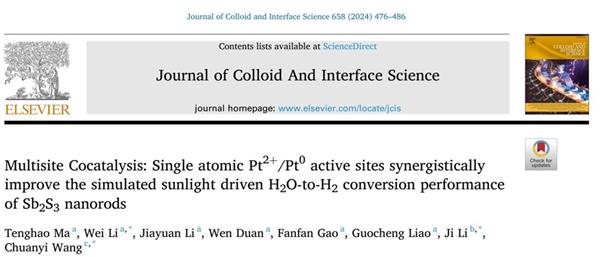- Multisite Cocatalysis: Single Atomic Pt2+/Pt0 Active Sites Synergistically Improve The Simulated Sunlight Driven H2O-to-H2 Conversion Performance of Sb2S3 Nanorods
- 来源:李伟教授个人网站 2024-01-25

Single atomic metal (SAM) cocatalysis is a potential strategy to improve the performance of photocatalytic materials. However, the cocatalytic mechanism of SAM sites in different valence states is rarely reported. Herein, single atomic Pt2+/Pt0 active sites were anchored on Sb2S3 nanorods to synergistically improve the photoactivity for hydrogen production under simulated sunlight. Experimental results and density functional theory calculations indicated that the coexistence of single atomic Pt2+/Pt0 sites synergistically improves the broadband light harvesting and promotes the Sb2S3-to-Pt electron transfer following inhibited photoexciton recombination kinetics and enhanced H proton adsorption capacity, resulting higher and more durable photoactivity for hydrogen production. Therefore, the optimal Sb2S3-Pt0.9‰ composite catalyst achieved remarkably enhanced hydrogen evolution rate of 1.37 mmol?g-1?h-1 (about 105-fold greater of that of Sb2S3 NRs) under faintly alkaline condition, and about 5.41% of apparent quantum yield (AQY700 nm) was achieved, which shows obvious superiority in hydrogen production by contrasting with the reported Sb2S3-based photocatalysts and conventional semiconductor photocatalytic materials modified with noble metals. This study elucidate a well-defined mechanism of multisite cocatalysis for photoactivity improvement.
- [来源:中国聚合物网]
- 了解更多请进入: 李伟教授个人网站
- · Hydrophilicity improvement of PVDF-networked CdS/TiO2 photocatalytic membrane for flat-panel purification of pharmaceutical wastewater accompanied by Cr(VI) reductio
- · Improved solar-powered water-splitting performance of Bi4Ti3O12/TiO2 composite with synergistically interacted heterointerfaces under platinum cocatalysis
- · Platinum co-catalysis modulation of exciton dynamics and film loading for durably photoactive benzyl alcohol value-added conversion and hydrogen co-production
- · Polyvinylidene fluoride-networked Sb2S3/CdS/Ag2S membrane with dual-junction exciton dynamics for in-depth purification of textile printing/dyeing wastewater